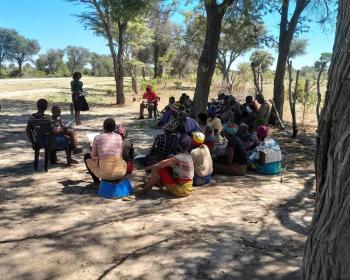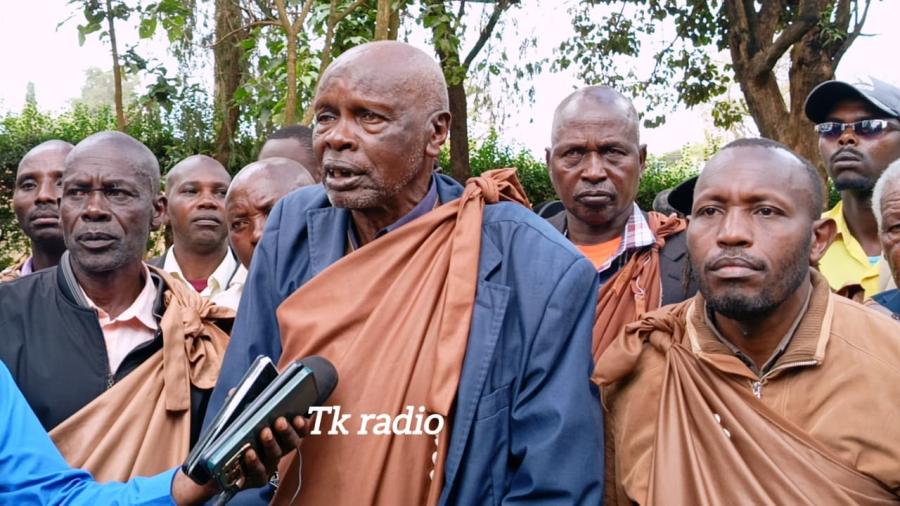Shambling with his four goats through the white dust of central Owambo in northern Namibia, Aaron Shipena cuts a sad and disheveled figure. With knapsack over his shoulder, this wizened man in ill-fitting clothes - older and wiser than an observer might guess - has set off on the long search for grazing space in a flat landscape devoid of grass and surface water. Tree cover, too, is fast disappearing under unprecedented pressure for cultivable land and wood for fuel and construction. Areas that 10 to 15 years ago were densely wooded now form unrecognizable expanses on which small copses and individual trees loom conspicuously.
In September the first winds whip up dense clouds of sand, which should be supporting next year's crops. Already the heart sucks moisture through one's skin like a dehydrating sponge; things will get far worse before the first rains - if they come - in late October or November. Because last year's rainfall here was reasonable and the network of water canals, pipes, and wells is expanding, most cattle and goats are still sleek and strong. In drought-stricken communal lands further into the arid northwest, however, these animals are dying in large numbers. cases of human malnutrition are also appearing.
This is no Somalia or Sahel, yet the situation could soon resemble those human and ecological disaster areas. Too many people still consider the principal problem here in Namibia to be drought and inadequate water for livestock. Certainly both the impact and severity of drought are increasing, but these actually constitute symptoms of a far more serious, underlying problem, namely, greater - and unsustainale - pressure on the environment. The process has been taking place for decades, albeit not at a critical pace until recently. While environmental decline is not restricted to communal lands, it is most acute on these lands, threatening the very survival of the hundreds of thousands of people who make their homes here. for them, time is running out.
COLONIALSM LEAVES A LEGACY
The last colony in sub-Saharan Africa, Namibia finally gained independence from South Africa on March 21, 1990, under UN supervision. To date, the transition has been remarkably smooth. Supportered by a healthy dose of international goodwill, the leaders of the South West African Peoples Organization (SWAPO), have made the difficult transition from a largely exiled liberation movement to a working government. However, tackling inherited structural problems, perhaps most conspicuously the land question, has been slow.
As in other former colonies, Namibia's land has become the most potent symbol of inherited inequalities and majority power. Hence, it is the focus of popular aspirations. Newly independent states often have sought to gain popularity and assuage this land hunger through land redistribution schemes, either on a "willing seller-willing buyer" basis or through nationalization. However, Nambia's arid to semi-arid environment imposes severe limitations on what can be done via this approach.
Most of Namibia receives under 20 inches of annual rainfall, and even the wettest northeast corner of the country averages only around 30 inches. The irregularity and variability of the rains pose added problems, and drought cycles are endemic. With the principal exception of Namibia's potential granary - the rich, cereal-producing karstveld triangle centered between the towns of Otavi, Grootfontein, and Tsumeb - there is little potential for the sort of intensive, small-scale cultivation that would increase significantly the number of people supported by the land. Here, plentiful ground water renders irrigation possible, but little is known about whether this is a renewable subterranean resource. Elsewhere, much marginal land in both the commercial and communal areas already suffers degradation through excessive pressure. In some areas, introducing permanent water points into communal lands actually exacerbates the degradation problems by allowing year-round grazing without adequate management.
Most of southern Africa's indigenous societies had evolved relatively sustainable economic systems before the arrival of Europeans. Whether based on pastoralism or on mixed farming, human and animal population densities were relatively low by today' standards. Acute environmental knowledge, transhumance (seasonal migration), trade, and specific measures, such as the subdivision of large royal and chiefly herds, enabled people to avoid degrading the land on which they depended so directly. All was not sublime rural bliss, however, and warfare and raiding were common. Such aggressions did serve to redistribute livestock and, indeed, people, when competition for land and water - the ultimate resources - increased.
Throughout the southern African region, nowhere more conspicuously than in South Africa and Namibia, colonial conquest and settlement proceeded by confining the surviving indigenous groups within small "native reserves" (later called "bantustans" and "home-land"). For the most part located in peripheral areas, and often comprised of land with medium to poor agricultural potential and thus of little interest to the settlers, these reserves couldn't support their growing populations. Indeed, one of the colonial objectives in establishing the system of so-called "traditional" government, based on conservative chiefs and headmen, was to force men, in particular, to sell their labor to the colonists. Where the genuine leaders opposed such clientilist roles of subservience to the conquerors, the latter deposed them in favor of more pliant accomplices.
Over time, population growth, often greatly exacerbated by the forced removals of African from "white" areas, increased the problems of overcrowding, as did the poor levels of infrastructure and agricultural extension. Today, fallow periods have either shrunk or been eliminated, and all available land - no matter how marginal - has been brought under cultivation. Access to credit, markets, and advice on agricultural practices often was systematically denied to prevent competition with commercial settler agriculture. As livestock herds have increased, the lack of access to seasonal grazing outside the reserve boundaries - areas that traditionally allowed pasture lands to recover - has led to more severe overgrazing.
RELATIONSHIPS BREAK DOWN
Under such land pressures and with the increasing integration of these areas into the money economy, not to mention the war for independence in northern Namibia, social relations have been pro-foundly transformed. Traditional communal land-allocation mechanisms and management system have broken down. In the past, the chief or headman held cultivate land in common and (re)distributed it according to need, ability to cultivate, and (no doubt) patronage. Any fees or tributes exacted from the recipients were related to wealth (usually herd size). Grazing land was generally on common land, open to all and subject to controls to prevent overgrazing.
However, human and livestock pressures were far lower at that time than today. Recently, the land-allocation system has become increasingly based on individual tenure. In particular, those with political power or the necessary cash or cattle resources - i.e., the wealthy elite - pay headmen for the right to fence off areas of grazing land, without regard to other right-holders; some tracts are as large as commercial ranches.
Apart from reducing the available common grazing area, the fences frequently cut other villagers off from water or seasonal migration routes. Moreover, cattle owned by the fencers are usually left to graze the remaining communal lands during the wet and early dry seasons, greatly exacerbating the environmental pressure there. Once these areas have been de-nuded, the fencers move their livestock inside the "privatized" areas to monopolize the fresh grazing. Outside the fences, other people's animals deteriorate rapidly and face a greater risk of dying.
Complaints by the victims of this practice to the elite or headmen generally fall on deaf ears. The Namibian government, under considerable political pressure, has condemned this practice and declared it illegal, but enforcement is lax, and the fenced areas increase rapidly each year. This is one instance of the wider problem of discordance between so-called "customary" law and statute law. In an added complication, the Namibian government has indicated its intention to reduce the powers of traditional leaders, who seem to be exploiting every opportunity to increase their power and wealth regardless of the social and environmental impacts.
Despite the commercialization of certain key transactions giving rise, in effect, to individual tenure rights, the underlying tenure system in Namibia has not formally changed. Nor is it at all clear that formally and totally privatizing communal land is the way to go. Undoubtedly, to do so would greatly increase the number of landless poor, for whom few nonagricultural opportunities exist, and enrich a small and already well-endowed minority.
Other alternatives, then, must be investigated as a matter of urgency. Already, the government's expansion of the water pipeline system is threatening marginal areas - hitherto spared because of salinity or by the absence of water during the dry season - with rapid degradation of the sort that has taken place in more densely settle areas. Careful research and integrated rural development geared to local circumstances in each region are urgently needed. Central to such initiatives must be an appropriate land and livestock management system that retains some of the positive community-oriented elements of traditional systems and avoids the problems of dispossession, narrow self-interest, and land speculation of fully privatized freehold tenure.
Only then will there be a realistic prospect of preventing the knot binding people to the land from unraveling further. Even so, it is most unlikely that communal areas in northern Namibia and in South Africa will be able to support their present populations adequately. Fortunately, many younger people have no aspirations to a life on the land, even if they do wish to retain inherited rights to land. At least, then, Aaron Shipena may have a slightly brighter future as he advances in years.
IN SEARCH OF FUEL
The vast majority of rural and urban people in northern Namibia rely on wood in some form for virtually all their fuel requirements. As population pressures increase and wood supplies dwindle, collecting firewood becomes more time consuming and arduous. This can have a marked effect on women, who traditionally have undertaken such work. Men's role in collecting firewood is still largely confined to felling trees for construction or fencing purposes. The scarcity of wood has given rise to commercial fuelwood collection, including transporting wood over long distances from areas where supplies are still more plentiful to those of high demand.
The transformation of fuelwood into a commodity that is bought and sold may create difficulties for poorer households. One common response in many countries, and one that many are exhibiting in northern Namibia, is "downward" substitution - of dung and crop residues for wood.
This diversion of fertilizer from the soil, in turn, is reducing future crop yields. In an effort to arrest fuelwood demand, Nordic development agencies are sponsoring a large-scale rural electrification scheme in the Owambo region of northern Namibia, in cooperation with the Namibian government. However, even this poses questions of affordability and of availability to individual homesteads, even if high-voltage power lines pass nearby.
Article copyright Cultural Survival, Inc.



